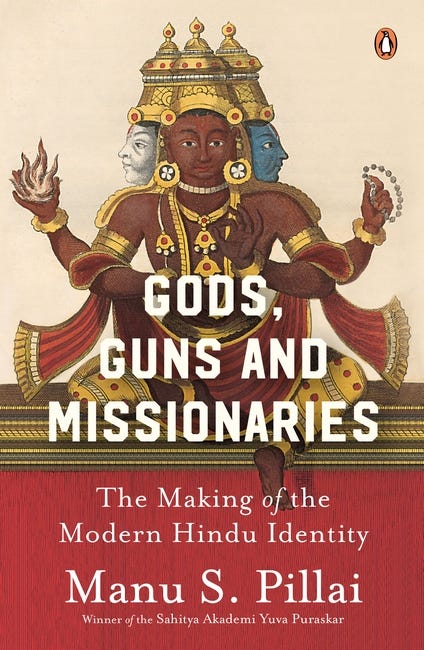Manu Pillai thrives as a storyteller. He has a penchant for finding and teasing out the more amusing stories that make the project of history specific and give it a form and shape that instantly makes it more recognisable. In Gods, Guns and Missionaries, Pillai casts his net wide to bring stories from different points in India’s colonial history, all tied together to illustrate his larger narrative about Hinduism’s encounter with European colonialism.
Pillai’s thesis is simple: the modern Hindu identity developed in response to colonialism and as a counter to the latter’s framing of the native society — and further, that this identity is what drives Hindu nationalism in India today. Starting with the arrival of the Portuguese Empire and Jesuit missionaries, the book traces the European encounter with and interpretation of the Hindu society from the 1500s and the various reactions and responses this elicited in the indigenous society. Its early chapters are a litany of action and reaction: zealous missionaries encounter heathens, conversions by sword set off a flight of people and deities from places like Goa, travellers’ and missionaries’ accounts of what Hinduism is deal in lurid details and peddle hysteria back in Europe and so on. Its second half is about what Pillai calls the Hindu response. Here, there is a prince who sought to balance Western thought and their relationship with Hinduism, who tried to modernize while remaining Hindu; reformers like Ram Mohan Roy or Dayanand Saraswati who worked hard to recast Hinduism, or those like Jyotirao Phule, whose response involved an attack on casteism; and finally those, like Tilak or Savarkar, who infused the identity with a political life.
True to form, Pillai peppers his account with stories that help tie his cast of characters together within a larger context. Through these, he arrives at what forms the thrust of his argument: that the modern Hindu identity drew on the very same Western (and often colonial) tropes it sought to counter. The bigger aim, metanarratively speaking, is to bust the myth of a monolithic, “true” Hinduism and highlight, instead, its fluidity and an almost intrinsic ability to adapt.
In itself, Pillai’s thesis is based on sound logic, and he is earnest in his presentation. Like with his other books, this too is engaging, and Pillai finds stories to support his claims from different corners of the country. It is unfortunate then that the book, on multiple occasions, fell just short of being all-round interesting.
For one, it fails to go beyond being a summary of already well-known Hindu reformers and ideologues. While there is commendable effort to weave the Brahmins in 16th-century Kerala and the likes of Ram Mohan Roy or Tilak in the same story, the book barely scratches the surface of what these efforts did for the Hindu community or the faith – or, for that matter, how the wider public perceived these efforts. In the process, the full effect of these enduring intellectual counters is never really felt. For instance, towards the end of the book, Pillai discusses Tilak’s public celebration of the Ganesh festival and the thought that drove this, but wouldn’t it be more interesting to excavate the public meaning this generated in the years after? Even as it rightfully criticises European conceptions of Hinduism as “top-down”, it also only engages with top-down responses to it. What about the masses that participated in the practice of religion? How, for instance, did the changing dimensions of religious practice fit into the architecture of the emerging identity?
This leads to some curious omissions and, for want of a better term, presumptions. The most serious of these is a complete absence of tribal voices, especially those from India’s Northeast. Missionaries – both Catholic and Protestant – arrived in the Brahmaputra Valley in the 1830s and in the subsequent years, were part and parcel of the network of colonial expansion in the region. Colonial administrators in the Chittagong and Naga Hills frequently wrote to their superiors about the role that missionaries had to play in “civilizing” and “taming” the regions’ tribes and thereby allowing the state to rule over these spaces more effectively. Similar models of conquest were deployed in other tribal belts in Odisha, Jharkhand, and the Chhotanagpur Plateau. To then omit the question of identity as it played out in these quarters is disorienting.
Related to this is the book’s presupposition of a difference between the religious and the political encounter between colonialism and Hinduism – but can they be separated in the colonial context? Colonialism’s missionary dimension, after all, was never far off. Similarly, on the other side, it would be worthwhile to investigate if, in how they adapted to colonialism, Pillai’s cast of thinkers saw a similar difference between religious and political identity in theory and practice. Gods, Guns and Missionaries seems to say there is a difference, but is unable to explain where this lies.
I’m not yet sure if the book deserves this blame for what it does not include, but these are, to my mind, noteworthy. In its defence, it is a closed circuit of a book: it answers the questions it opens with. However, for a society that emerged from colonialism bent this way and that, to end the book where it began — with Hinduism not as a monolith — seems like somewhat of an anticlimactic self-fulfilling circuit. Moreover, for a society where the response to colonialism was differentiated by region, ethnicity, caste, and class, these omissions are striking. But perhaps that is another book.




